Ionarts at Large: Neeme Järvi, Tubin, and the BRSO

Five numbers from Carl Nielsen’s Aladdin Suite and Dvořák’s Cello Concerto had preceded this – both of fine quality but far from either special or memorable. The opening “Oriental Festival March” of the Suite was an unrelenting and weighty affair with a surprisingly fat and dense sound from the usually refined BRSO. Entertaining was, as should be, the skip in the violins’ step that probably connotes the oriental nature, in case the overt triangle and extra percussion didn’t already give it away.
After the onslaught came the deft delicacy of “Aladdin’s Dream” before the “Dance of the “Morning Mists” tip-toed to the “Hindu Dance” where the BRSO winds shone. The “Chinese Dance” offered swinging Chinøiserie coaxed along by Järvi before the “Negro Dance” (“Isaphan Marketplace” and “Prisoner’s Dance” from Nielsen’s posthumously published seven-part suite were skipped ) made its odd exclamation mark with puffed cheeks, stomping around the campfire. This part is visual to the point of camp – rambunctious and untamed, a fun ride of a charmingly(?) outdated sort... certainly miles away from Nielsen’s strangely age-eschewing, even modern symphonies.

All in all not worth expanding even this many words on – because they should have all been saved for what followed after intermission: Neeme Järvi brought out all the great qualities of the BRSO in a performance of Eduard Tubin’s Fifth Symphony. Järvi has tirelessly promoted the music of his fellow Estonian Tubin (1905 – 1982) for nearly three decades. We cannot thank him enough for this Tubin-evangelism because he really has brought us the good word (or music, rather). In "Surprised by Beauty", Robert R. Reilly writes "[t]here is no [mention of] Tubin in my handy musical dictionary -- or in any other book I have on 20th-century music. [He has] slipped down the same memory hole that swallowed his native Estonia after it was occupied by the Soviet Union along with the other Baltic states in 1940. But like Estonia, Tubin’s music is back, though the composer unfortunately did not live long enough to see his country liberated. [...] The Fifth Symphony(1946) is the first product of Tubin’s exile. It shows that Tubin had cast aside anything inessential to symphonic form."
E.Tubin, Symphony No.5, Kratt-Suite, N.Järvi / Bamberger SO
So it does, indeed. It's a three movement example of Shostakovich-meets-Sibelius with a pounding opening Allegro energico that ratchets up the tension akin to the Shostakovich’s style, but arranged in blocks upon which I feel Bruckner to smile knowingly from above. The whole movement hurls itself to an open-ended question mark of a climax.
Beauty askew abounds in the searing slow movement where similarities to Shostakovich recede in favor of something more Carl Nielsen-ish. It is marked by chorale-like elements, a beautiful solo violin passage, and extremely dense textures from which the string sections are released into (temporary) freedom. A freedom followed immediately by melancholy. This is a movement as touching as any of the best moments in 20th century symphonism.
The Finale opens with cellos and basses marching beneath the violins playing a circuitous holding pattern while the heavy-booted brass snarls and exclaims. Tubin, who found refuge in Stockholm when his Estonia was overrun by the Soviets in 1944, made a meager living by arranging baroque music at the Drottningholm Theater. The spirit of Drottningholm is far, far away from this Allegro assai. The strings turn to a chilling, icy, eerie orchestral exhalation before trumpet fanfares ring in a last climax. The symphony ends in gut-wrenching procession over unforgiving figures of two timpanists (the principal timpanist of the Munich Philharmonic helped out) who are busy making the finale of Nielsen’s “Inextinguishable” seem meek in comparison.
Stirring and enthralling stuff, at least for all music lovers who are ready to embrace the symphonic works from Nielsen to Schnittke, Sibelius to Rubbra, Shostakovich to Rautavaara. The small but hardy bunch among the audience that refused to let Järvi go got treated to Sibelius’ Andante Festivo, a wholly moving nightcap from the BRSO’s glowing string section.
The concert was broadcast live on Bayern 4.





















































No comments:
Post a Comment